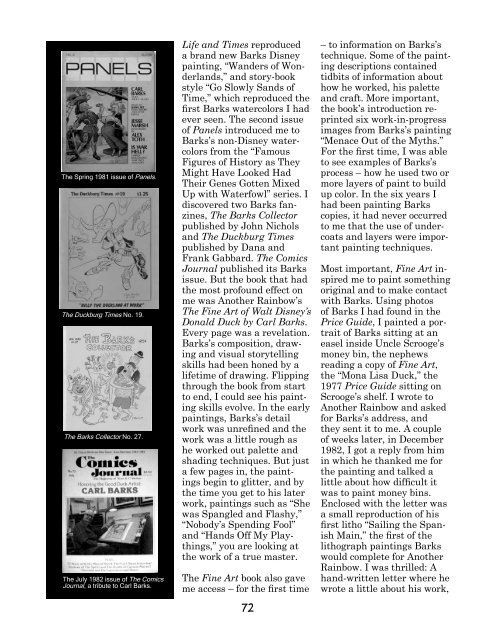Painting Fine-Art Cartoons in Oils - Enchanted Images
Painting Fine-Art Cartoons in Oils - Enchanted Images
Painting Fine-Art Cartoons in Oils - Enchanted Images
Create successful ePaper yourself
Turn your PDF publications into a flip-book with our unique Google optimized e-Paper software.
The Spr<strong>in</strong>g 1981 issue of Panels.<br />
The Duckburg Times No. 19.<br />
The Barks Collector No. 27.<br />
The July 1982 issue of The Comics<br />
Journal, a tribute to Carl Barks.<br />
Life and Times reproduced<br />
a brand new Barks Disney<br />
pa<strong>in</strong>t<strong>in</strong>g, “Wanders of Wonderlands,”<br />
and story-book<br />
style “Go Slowly Sands of<br />
Time,” which reproduced the<br />
first Barks watercolors I had<br />
ever seen. The second issue<br />
of Panels <strong>in</strong>troduced me to<br />
Barks’s non-Disney watercolors<br />
from the “Famous<br />
Figures of History as They<br />
Might Have Looked Had<br />
Their Genes Gotten Mixed<br />
Up with Waterfowl” series. I<br />
discovered two Barks fanz<strong>in</strong>es,<br />
The Barks Collector<br />
published by John Nichols<br />
and The Duckburg Times<br />
published by Dana and<br />
Frank Gabbard. The Comics<br />
Journal published its Barks<br />
issue. But the book that had<br />
the most profound effect on<br />
me was Another Ra<strong>in</strong>bow’s<br />
The <strong>F<strong>in</strong>e</strong> <strong>Art</strong> of Walt Disney’s<br />
Donald Duck by Carl Barks.<br />
Every page was a revelation.<br />
Barks’s composition, draw<strong>in</strong>g<br />
and visual storytell<strong>in</strong>g<br />
skills had been honed by a<br />
lifetime of draw<strong>in</strong>g. Flipp<strong>in</strong>g<br />
through the book from start<br />
to end, I could see his pa<strong>in</strong>t<strong>in</strong>g<br />
skills evolve. In the early<br />
pa<strong>in</strong>t<strong>in</strong>gs, Barks’s detail<br />
work was unref<strong>in</strong>ed and the<br />
work was a little rough as<br />
he worked out palette and<br />
shad<strong>in</strong>g techniques. But just<br />
a few pages <strong>in</strong>, the pa<strong>in</strong>t<strong>in</strong>gs<br />
beg<strong>in</strong> to glitter, and by<br />
the time you get to his later<br />
work, pa<strong>in</strong>t<strong>in</strong>gs such as “She<br />
was Spangled and Flashy,”<br />
“Nobody’s Spend<strong>in</strong>g Fool”<br />
and “Hands Off My Playth<strong>in</strong>gs,”<br />
you are look<strong>in</strong>g at<br />
the work of a true master.<br />
The <strong>F<strong>in</strong>e</strong> <strong>Art</strong> book also gave<br />
me access – for the first time<br />
72<br />
– to <strong>in</strong>formation on Barks’s<br />
technique. Some of the pa<strong>in</strong>t<strong>in</strong>g<br />
descriptions conta<strong>in</strong>ed<br />
tidbits of <strong>in</strong>formation about<br />
how he worked, his palette<br />
and craft. More important,<br />
the book’s <strong>in</strong>troduction repr<strong>in</strong>ted<br />
six work-<strong>in</strong>-progress<br />
images from Barks’s pa<strong>in</strong>t<strong>in</strong>g<br />
“Menace Out of the Myths.”<br />
For the first time, I was able<br />
to see examples of Barks’s<br />
process – how he used two or<br />
more layers of pa<strong>in</strong>t to build<br />
up color. In the six years I<br />
had been pa<strong>in</strong>t<strong>in</strong>g Barks<br />
copies, it had never occurred<br />
to me that the use of undercoats<br />
and layers were important<br />
pa<strong>in</strong>t<strong>in</strong>g techniques.<br />
Most important, <strong>F<strong>in</strong>e</strong> <strong>Art</strong> <strong>in</strong>spired<br />
me to pa<strong>in</strong>t someth<strong>in</strong>g<br />
orig<strong>in</strong>al and to make contact<br />
with Barks. Us<strong>in</strong>g photos<br />
of Barks I had found <strong>in</strong> the<br />
Price Guide, I pa<strong>in</strong>ted a portrait<br />
of Barks sitt<strong>in</strong>g at an<br />
easel <strong>in</strong>side Uncle Scrooge’s<br />
money b<strong>in</strong>, the nephews<br />
read<strong>in</strong>g a copy of <strong>F<strong>in</strong>e</strong> <strong>Art</strong>,<br />
the “Mona Lisa Duck,” the<br />
1977 Price Guide sitt<strong>in</strong>g on<br />
Scrooge’s shelf. I wrote to<br />
Another Ra<strong>in</strong>bow and asked<br />
for Barks’s address, and<br />
they sent it to me. A couple<br />
of weeks later, <strong>in</strong> December<br />
1982, I got a reply from him<br />
<strong>in</strong> which he thanked me for<br />
the pa<strong>in</strong>t<strong>in</strong>g and talked a<br />
little about how difficult it<br />
was to pa<strong>in</strong>t money b<strong>in</strong>s.<br />
Enclosed with the letter was<br />
a small reproduction of his<br />
first litho “Sail<strong>in</strong>g the Spanish<br />
Ma<strong>in</strong>,” the first of the<br />
lithograph pa<strong>in</strong>t<strong>in</strong>gs Barks<br />
would complete for Another<br />
Ra<strong>in</strong>bow. I was thrilled: A<br />
hand-written letter where he<br />
wrote a little about his work,


